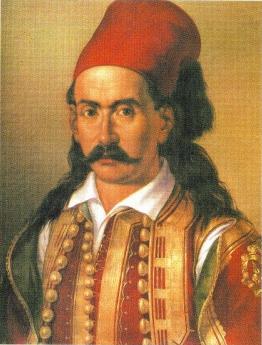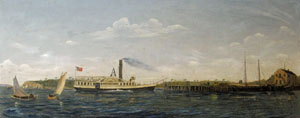Historical Paintings of Woods Hole and Falmouth by F. L. Gifford

Click here to read to Gifford's notes about this painting.
The Story of the Marco Bozzaris
In Gifford’s description of this painting ( printed below), includes some basic information: the Marco Bozzaris was a steamer that ran between New Bedford, Martha’s Vineyard, and Woods Hole; it had two copper boilers; and it was in service from 1829 until 1832.
But there’s more to the story, pieces that Gifford, having been born in 1850 and writing his notes in the 1930s, might have known and assumed that his readers would know. For us, reading his notes 80 years later, there are many missing pieces. Here are some of them.
The story begins with Jacob Barker, a wealthy merchant and financier. According to Harry B. Turner in The Story of the Island Steamers,
Jacob Barker was the first man to ship cotton from this country to St. Petersburg, and he was something of a financial power.... At the outbreak of the war of 1812 he was employed by the government to raise a loan of five million dollars, and he was accredited with being successful in every undertaking…. He supplied the government for seven years with all the oil used in the lighthouses of the United States, and died in Philadelphia in December, 1871, after a remarkable career, at the age of ninety-two years.
Barker was also connected to the first steamboat built in America. In 1806 he had imported “on consignment to himself by a London house, ‘for Robert Fulton,’ the first steam engine ever used in the propulsion of vessels.” Fulton, of course, built the first commercially successful steamboat in 1807. It carried passengers from New York City to Albany.
Although Barker was a New Yorker, he had connections to Nantucket and he decided that “the inauguration of steam navigation of the right sort would prove of great benefit to the island.” So he had a steamer constructed at his own expense. By 1829 the steamer was ready to go, but one problem remained… it didn’t have a name.
Here again is Harry Turner’s account…
There is an interesting story connected with the selection of a name for the steamer which he was having built for Nantucket. Mr. Barker wanted a name which had originality, and day after day he pondered over the problem. One morning when he entered his counting room, where he had several young men employed, he noticed one of them sitting with bowed head, as if in deep thought, with a quill pen poised in his hand. "Good morning, Halleck!" said Mr. Barker. "What are you writing this morning?" "Oh, just a few stanzas, while I was waiting for you to come in," was the reply. "Let me read it and see how it sounds," said his employer. This is what he read:
MARCO BOZZARIS.
At midnight, in his guarded tent,
The Turk was dreaming of the hour
When Greece, her knee in suppliance bent,
Should tremble at his power.
At this point, most of us would have to say, “Who is Marco Bozzaris?” That’s not what Barker did. Back to Turner’s version...
"Good!" exclaimed Merchant Barker. "That is just the name for my little steamer!" And the "Marco Bozzaris" she became. The young man was Fitz-Greene Halleck, who later became a poet of some renown, and was the confidential adviser of John Jacob Astor, and a trustee of the Astor Library. His poem "Marco Bozzaris" was considered his masterpiece, and it was while in Jacob Barker's employ that it was written, and the little 140-tons steamer which came to Nantucket in the spring of 1829 bore the name of "Marco Bozzaris."
So that’s two people — Barker and Halleck — both of whom were famous during the early 19th Century and of whom we are likely never to have heard. But who is Marco Bozzaris?
At the beginning of the 19th Century, Greece was not an independent country: it had been part of the Ottoman Empire for 500 years. In 1821 the Greeks began a war for independence. Since the war pitted Christian Greeks against Muslim Turks, it aroused considerable passion and was closely followed by people all over western Europe and America. This war and Marco Bozzaris, a Greek hero of the war, captured the imagination of Fitz-Greene Halleck and many others. For example, Lord Byron, a poet far more famous today than Halleck, went to Greece as a volunteer to fight the Turks and died there 1824, near where Bozzaris fought his greatest battle.
So Marco Bozzaris was a Greek commander in the war against the Turks. In 1823, he led an attack that made him famous, 350 Greeks against 1000 Ottomans, in the defense of Missolonghi. The Ottomans were defeated. Bozzaris fought bravely and then died from a bullet to the head, shot as his men carried him wounded from the battlefield. He is still a hero in Greece.

In 1829, as Halleck wrote his poem and Barker searched for a name for his steamboat, nearly everyone in America knew about Bozzaris and his bravery. So when Barker saw Halleck’s poem, he didn’t say, “Who is Marco Bozzaris?” He said, “That is just the name for my little steamer!”
You can read more about Bozzaris and the battle here.
You can read all of Fitz-Greene Halleck’s poem about Marco Bozzaris here. By the way, there’s a statue of Fitz-Greene Halleck in New York’s Central Park. And here is a link to the full text of Harry B. Turner's book, The Story of the Island Steamers (The Inquirer and Mirror Press, Nantucket, Mass. 1910).
Gifford's Notes
The steamboat shown at the wharf is the "Marco Bozzaris", the third steamer to ply between New Bedford, Woods Hole, and the Vineyard. This 140-ton vessel, with twin copper boilers, burned wood for fuel until June 1831 when it was decided to experiment with coal.
The "Marco Bozzaris" was in service from April 29, 1829 until the summer of 1832. A stagecoach for Boston and way stations made connections with this boat at Woods Hole. The coach was driven by William Hewins at this time.
The two fishing boats with pink sterns were owned by Colonel Bourne together with the small building on the wharf (53). Colonel Bourne owned several fishing schooners and operated them in conjunction with many smaller boats from 1825 to 1848. His catches of codfish were dried, salted, and traded along the coast as far as New York in exchange for provisions.
The text above is from Historical Paintings of Woods Hole, by Franklin Lewis Gifford (Woods Hole Public Library, 1962). The numbers in parentheses refer to Gifford's "Map of Woods Hole as of 1845," which you can see by clicking here.
The Sortie at Missolonghi.
From Mosaics of Grecian History by Marcius Willson and Robert Pierpont Willson, pages 325-326. (You can see the whole book here.)
One of the noted exploits of the Greeks in 1823, and one that has been commemorated in many ways, occurred at Missolon'ghi, the capital of Acarnania and AEtolia, while that town was besieged by a Turkish army; and the name of Marco Bozzar'is, the commander of the garrison, has ever since been classed with that of Leonidas and other heroes of ancient Greece who fell in the moment of victory. In his Crescent and the Cross; or, Romance and Realities of Eastern Travel, the English author WARBURTON thus tells the story of the well-known deed that saved Missolonghi to the Greeks and hastened the delivery of their country:
"When Missolonghi was beleaguered by the Turkish forces, Marco Bozzaris commanded a garrison of about twelve hundred men, who had barely fortifications enough to form breastworks. Intelligence reached him that an Egyptian army was about to form a junction with the formidable besieging host. A parade was ordered of the garrison, 'faint and few, but fearless still.' Bozzaris told them of the destruction that impended over Missolonghi, proposed a sortie, and announced that it should consist only of volunteers.Volunteers! The whole garrison stepped forward as one man, and demanded the post of honor and of death. 'I will only take the Thermopylae number,' said their leader; and he selected the three hundred from his true and trusty Suliotes.
"In the dead of night this devoted band marched out in six divisions, which were placed,in profound silence, around the Turkish camp. Their orders were simply, 'When you hear my bugle blow seek me in the pasha's tent.'"Marco Bozzaris, disguised as an Albanian bearing dispatches to the pasha from the Egyptian army, passed unquestioned through the Turkish camp, and was only arrested by the sentinels around the pasha's tent, who informed him that he must wait till morning.
"Then wildly through the stillness of the night that bugle blew; faithfully it was echoed from without; and the war-cry of the avenging Greek broke upon the Moslem's ear. From every side that terrible storm seemed to break at once; shrieks of agony and terror swelled the tumult. The Turks fled in all directions,and the Grecian leader was soon surrounded by his comrades. Struck to the ground by a musket-ball, he had himself raised on the shoulders of two Greeks; and, thus supported, he pressed on the flying enemy. Another bullet pierced his brain in the hour of his triumph, and he was borne dead from the field of his glory."
But Missolonghi was saved, and under Constantine and Noto Bozzaris,brothers of the dead hero, it withstood repeated assaults of the Turks, until, in 1826, after having been besieged for overa year by a very large naval and military force, it was finally taken. Those left of the small garrison who were able to fight, placing the women in the center, sallied forth at midnight of the 22d of April, and cut their way through the Turkish camp; while those who were too feeble to attempt an escape assembled in a large mill that was used as a powder-magazine, and blew themselves and many of the incoming Turks to atoms.
